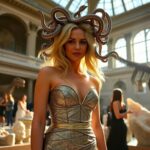Table of Contents
The power of image: How fashion shapes political narratives
In the world of politics, the way a candidate presents themselves can be just as important as their policies. As we witness the rise of new political figures, particularly among younger generations, the intersection of fashion and politics has never been more pronounced.
This phenomenon is not just about aesthetics; it’s a strategic tool that can influence public perception and voter behavior.
Fashion as a political statement
Fashion has always been a reflection of cultural and social values, but in the political arena, it takes on a new dimension.
For instance, when a nominee for a significant position, like Secretary of Defense, chooses to wear a bright blue suit paired with a red tie, it’s not merely a fashion choice; it’s a calculated move. This attire can evoke feelings of patriotism and allegiance, subtly signaling to the audience where their loyalties lie.
The colors of the American flag are not just a coincidence; they are a deliberate choice aimed at resonating with the electorate.
The influence of social media on political fashion
With the rise of social media, the impact of fashion in politics has expanded exponentially.
Platforms like Instagram and TikTok allow politicians to showcase their style choices to a broader audience, making fashion a vital part of their brand. Young voters, particularly Gen Z, are more likely to engage with candidates who present themselves authentically and stylishly.
This demographic values relatability and transparency, and a well-curated wardrobe can help bridge the gap between politicians and the public.
Case studies: Fashion in action
Take, for example, the recent confirmation hearing of a prominent political figure. The nominee entered the room to cheers and chants, dressed in a way that mirrored the classic uniform of the Trump administration.
This choice was not just about looking good; it was about embodying the values and aesthetics of a movement. Accessories like a flag-themed pocket square or star-spangled socks serve as visual cues that reinforce a candidate’s commitment to their cause. Such choices can create a narrative that resonates with voters, making them feel a sense of connection and loyalty.
The future of political fashion
As we move forward, the relationship between fashion and politics will likely continue to evolve. With younger generations becoming more politically active, the importance of image will only grow. Politicians will need to be more mindful of their fashion choices, understanding that every detail can contribute to their overall message. In a world where first impressions matter, the right outfit can make all the difference in shaping public perception.





